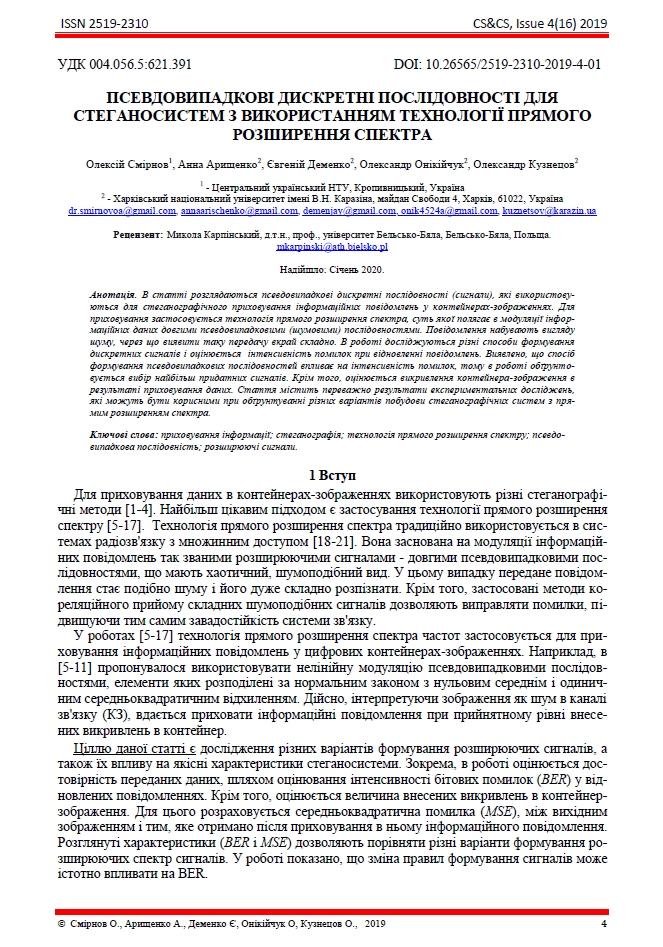Pseudorandom Sequences for Spread Spectrum Image Steganography
Abstract
We consider pseudorandom sequences (signals), which are used for information-hiding in cover images. Spread spectrum image steganography is used for the hiding, the essence of which is modulating information data with long pseudorandom (noise) sequences. Messages take the form of noise, and it is extremely difficult to detect such transmission. We investigate different ways of discrete signals generation and estimate the error rate in message restoration. It appears, the way of discrete signals generation influences on the error rate and we prove the choice of the most suitable signals. Moreover, we estimate distortions of the cover image as a result of data-hiding. The article mainly contains the results of experimental researches, which can be useful in justifying various ways of building direct spread spectrum steganographic systems.
Downloads
References
“Digital Watermarking and Steganography,” 2008. doi:10.1016/b978-0-12-372585-1.x5001-3.
F. Y. Shin, “Digital Watermarking and Steganography,” Dec. 2017. doi:10.1201/9781315219783.
N. F. Johnson and S. Jajodia, "Exploring steganography: Seeing the unseen," in Computer, vol. 31, no. 2, pp. 26-34, Feb. 1998. doi: 10.1109/MC.1998.4655281 .
V. S. Manoj, “Cryptography and Steganography,” International Journal of Computer Applications, vol. 1, no. 12, pp. 63–68, Feb. 2010. doi:10.5120/257-414.
A. Z. Tirkel, C. F. Osborne and R. G. Van Schyndel, "Image watermarking-a spread spectrum application," Proceedings of IS-SSTA'95 International Symposium on Spread Spectrum Techniques and Applications, Mainz, Germany, 1996, pp. 785-789 vol.2. doi: 10.1109/ISSSTA.1996.563231.
J. R. Smith and B. O. Comiskey, “Modulation and information hiding in images,” Lecture Notes in Computer Science, pp. 207–226, 1996. doi:10.1007/3-540-61996-8_42.
L. M. Marvel, C. G. Boncelet, R. Jr., and Charles T., “Methodology of Spread-Spectrum Image Steganography,” Jun. 1998. doi:10.21236/ada349102.
L. M. Marvel, C. G. Boncelet and C. T. Retter, "Spread spectrum image steganography," in IEEE Transactions on Image Pro-cessing, vol. 8, no. 8, pp. 1075-1083, Aug. 1999. doi: 10.1109/83.777088.
M. Kutter, “Performance Improvement of Spread Spectrum Based Image Watermarking Schemes through M-ary Modulation,” Lecture Notes in Computer Science, pp. 237–252, 2000. doi:10.1007/10719724_17.
F. S. Brundick and L. M. Marvel, “Implementation of Spread Spectrum Image Steganography,” Mar. 2001. doi:10.21236/ada392155.
Patent No.: US 6,557,103 B1, Int.Cl. G06F 11/30. Charles G. Boncelet, Jr., Lisa M. Marvel, Charles T. Retter. Spread Spectrum Image Steganography. Patent No.: US 6,557,103 B1, Int.Cl. G06F 11/30. – № 09/257,136; Filed Feb. 11, 1999; Date of Patent Apr. 29, 2003
Fan Zhang, Bin Xu and Xinhong Zhang, "Digital image watermarking algorithm based on CDMA spread spectrum," 2006 12th International Multi-Media Modelling Conference, Beijing, 2006, pp. 4 pp.-. doi: 10.1109/MMMC.2006.1651359.
T. T. Nguyen and D. Taubman, "Optimal linear detector for spread spectrum based multidimensional signal watermarking," 2009 16th IEEE International Conference on Image Processing (ICIP), Cairo, 2009, pp. 113-116. doi: 10.1109/ICIP.2009.5414121.
E. Nezhadarya, Z. J. Wang and R. K. Ward, "Image quality monitoring using spread spectrum watermarking," 2009 16th IEEE International Conference on Image Processing (ICIP), Cairo, 2009, pp. 2233-2236. doi: 10.1109/ICIP.2009.5413955.
S. Ghosh, P. Ray, S. P. Maity and H. Rahaman, "Spread Spectrum Image Watermarking with Digital Design," 2009 IEEE Inter-national Advance Computing Conference, Patiala, 2009, pp. 868-873. doi: 10.1109/IADCC.2009.4809129.
H. O. Altun, A. Orsdemir, G. Sharma and M. F. Bocko, "Optimal Spread Spectrum Watermark Embedding via a Multistep Fea-sibility Formulation," in IEEE Transactions on Image Processing, vol. 18, no. 2, pp. 371-387, Feb. 2009. doi: 10.1109/TIP.2008.2008222.
A. Samčović and M. Milovanović, "Robust digital image watermarking based on wavelet transform and spread spectrum tech-niques," 2015 23rd Telecommunications Forum Telfor (TELFOR), Belgrade, 2015, pp. 811-814.
doi: 10.1109/TELFOR.2015.7377589.
V. P. Ipatov, “Spread Spectrum and CDMA,” Mar. 2005. doi:10.1002/0470091800.
“Introduction to CDMA Wireless Communications,” 2007. doi:10.1016/b978-0-7506-5252-0.x5001-7.
“The Generalized CDMA,” CDMA: Access and Switching, pp. 1–28. doi:10.1002/0470841699.
S. Hara and R. Prasad, "DS-CDMA, MC-CDMA and MT-CDMA for mobile multi-media communications," Proceedings of Vehicular Technology Conference - VTC, Atlanta, GA, USA, 1996, pp. 1106-1110 vol.2. doi: 10.1109/VETEC.1996.501483.
S. S. Agaian, H. G. Sarukhanyan, K. O. Egiazarian, and J. Astola, “Hadamard Transforms,” Aug. 2011. doi:10.1117/3.890094.
“Probability Theory of Bit Error Rate,” Optical Bit Error Rate, 2009. doi:10.1109/9780470545430.ch7.
J. Korhonen and J. You, "Peak signal-to-noise ratio revisited: Is simple beautiful?," 2012 Fourth International Workshop on Quality of Multimedia Experience, Yarra Valley, VIC, 2012, pp. 37-38. doi: 10.1109/QoMEX.2012.6263880
“Data Compression,” 2007. doi:10.1007/978-1-84628-603-2.
Yu.V. Stasev, A.A. Kuznetsov, A.M. Nosik. “Formation of pseudorandom sequences with improved autocorrelation properties.” Cybernetics and Systems Analysis, vol. 43, Issue 1, pp. 1-11, January 2007. DOI: 10.1007/s10559-007-0021-2
N.I. Naumenko, Yu.V. Stasev, A.A. Kuznetsov. “Methods of synthesis of signals with prescribed properties.” Cybernetics and Systems Analysis, vol. 43, Issue 3, pp. 321-326, May 2007. DOI: 10.1007/s10559-007-0052-8
O. Karpenko, A. Kuznetsov, V. Sai, Yu. Stasev. “Discrete Signals with Multi-Level Correlation Function.” Telecommunications and Radio Engineering, vol. 71, 2012 Issue 1. pp 91-98. DOI: 10.1615/TelecomRadEng.v71.i1.100
A. Kuznetsov, S. Kavun, V. Panchenko, D. Prokopovych-Tkachenko, F. Kurinniy and V. Shoiko, "Periodic Properties of Cryp-tographically Strong Pseudorandom Sequences," 2018 International Scientific-Practical Conference Problems of Infocommuni-cations. Science and Technology (PIC S&T), Kharkiv, Ukraine, 2018, pp. 129-134. doi: 10.1109/INFOCOMMST.2018.8632021
A. Kuznetsov, O. Smirnov, D. Kovalchuk, A. Averchev, M. Pastukhov and K. Kuznetsova, "Formation of Pseudorandom Se-quences with Special Correlation Properties," 2019 3rd International Conference on Advanced Information and Communications Technologies (AICT), Lviv, Ukraine, 2019, pp. 395-399. doi: 10.1109/AIACT.2019.8847861


